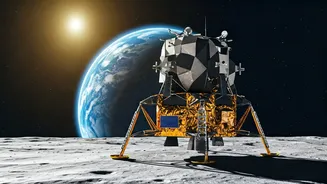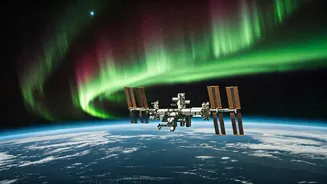Sun's Fury Unleashed
The sun, our nearest star, is in a period of heightened activity, significantly impacting our activities in space. Solar flares and coronal mass ejections
(CMEs) – massive bursts of energy and particles from the sun – are becoming more frequent and intense. These events can create geomagnetic storms, which disturb Earth’s magnetic field. This solar weather poses a serious threat to satellites orbiting Earth. When these storms occur, they can heat the upper atmosphere, causing it to expand. This expansion increases atmospheric drag, pulling satellites lower and potentially causing them to fall back to Earth. Satellites can also be directly damaged by energetic particles from the sun, which can interfere with their electronic systems, causing malfunctions or complete failure. This is particularly concerning for the increasing number of satellites in orbit, as they become more vulnerable to these solar events.
Starlink's Satellite Challenges
Recent occurrences have shown the tangible effects of solar activity. It was observed that a considerable number of Starlink satellites experienced difficulties and fell from the sky due to a geomagnetic storm. These satellites, crucial for providing internet services globally, were exposed to an environment of intense solar flares. As these satellites navigate Earth's orbit, their path is affected by an increasingly volatile upper atmosphere. The increased atmospheric drag caused by solar events can make satellites' orbital maintenance difficult or even unmanageable. This highlights the vulnerability of space infrastructure to solar disturbances. The incident serves as a crucial reminder of the importance of forecasting and mitigating the impact of space weather on satellite operations, especially given the growing reliance on these technologies.
Space Operations Cost Increase
The intensifying solar activity also directly affects the financial aspects of space operations. Satellite operators are forced to deal with increased costs for several reasons. Firstly, the risk of satellite loss due to solar events necessitates increased insurance premiums, raising the overall operational expenses. Secondly, to safeguard against solar storms, operators must invest in advanced monitoring systems and protective measures, such as enhanced shielding for satellites. Thirdly, in response to such dangers, space companies need to invest in a stronger understanding of space weather predictions and employ techniques to dodge the effects of solar flares and geomagnetic storms. Space companies must constantly adjust their strategies, including adjusting satellite orbits and operations. All these activities significantly contribute to the increase in the cost of conducting business in space. The financial implications stress the need for investment in space weather monitoring and mitigation strategies.
Future Considerations and Mitigation
As reliance on space-based technology increases, it is crucial to address the impact of solar activity on satellites and space operations. The future demands significant investments in improved space weather forecasting and early warning systems. These forecasts will allow operators to prepare for adverse conditions and implement necessary protective measures. Satellite design enhancements are also becoming more important, including building more resilient satellites with better shielding and robust electronic components. Furthermore, international cooperation is necessary to share space weather data and ensure best practices for space operations. This collaborative approach enhances the resilience of the space infrastructure and reduces the risk associated with solar events. As technology evolves and the frequency of satellite launches increases, a proactive strategy for solar event management is essential to secure the future of space activities and minimize the environmental impacts.











